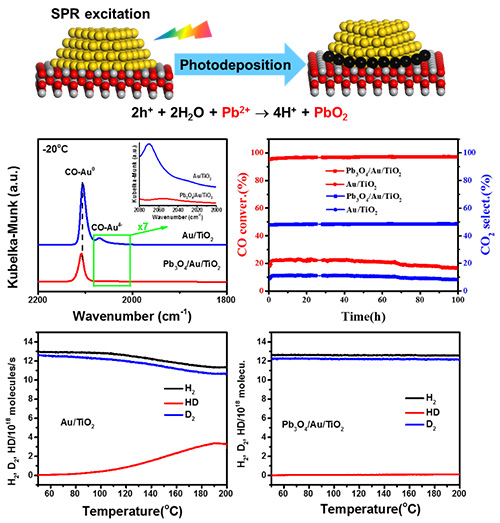Gold nanocatalyst is a potential catalyst for CO preferential oxidation (PROX) reaction. However, with the increase of reaction temperature, CO conversion and CO2 selectivity in PROX reaction decrease due to the enhanced competition oxidation of hydrogen, which leads to a narrow temperature window.
It's still a challenge to completely remove CO at a wide temperature window and meanwhile maintain superior stability in CO-PROX reaction.
Recently, Prof. LI Can's group and Prof. HUANG Jiahui's group from the Dalian Institute of Chemical Physics (DICP) of the Chinese Academy of Sciences (CAS) developed a photoexcited deposition of metal oxide (PDMO) method to improve the performance of the CO-PROX reaction.
This study was publisehd in Chem Catalysis on May 17 and granted a national invention patent.

Structure characterization and catalytic performance of prepared catalysts (Image by HONG Feng and WANG Shengyang)
The researchers developed a unique and visualized strategy to selectively modify the interfacial region of Au/TiO2 catalyst by a PDMO method based on the photocatalytic reactions induced by the surface plasmon resonance (SPR) of gold NPs. Au/TiO2 catalyst is a well-known gold nanocatalyst and also a representative plasmonic photocatalyst.
They modified the interface of Au/TiO2 catalyst, and eliminated CO in a very wide temperature range, which exhibited superior performance in CO-PROX reaction. Meanwhile, the decorated PbO2 also improved the long-term stability of Au/TiO2 even in a harsh condition.
"This study is promising for gold catalysts to remove the trace CO from H2 for proton-exchange membrane fuel cells and offers an elaborate interface modification method to design highly efficient gold-based catalysts," said Prof. HUANG.
This work was supported by the National Natural Science Foundation of China, National Key R&D Program of China, and the Strategic Priority Research Program of the CAS. (Text by HONG Feng and WANG Shengyang)